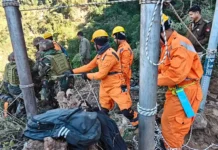Monday Musing
[ Tongam Rina ]
For a long time, Arunachal Pradesh didn’t even have an intensive care unit (ICU). Critically ill patients requiring ICU stay were routinely referred outside the state not just due to lack of facilities, but also because of safety concerns. In several cases, doctors were physically attacked.
In one incident, a doctor was prevented from treating a survivor of a fatal traffic accident because the relatives of the person who died in the collision objected.
In such situations, what are doctors supposed to do?
The establishment of the Tomo Riba Institute of Health and Medical Sciences (TRIHMS) finally brought ICU facilities to the state. But violence and obstruction of medical duties have not stopped. To safeguard health workers, Arunachal Pradesh enacted the Protection of Medical Service Institutions (Prevention of Violence and Damage or Loss of Property) Act, 2019.
The Act clearly defines any form of violence -physical or mental abuse – against medical personnel during or related to the discharge of their duties in hospitals, mobile clinics, or ambulances as punishable. The penalties include imprisonment ranging from 3 to 10 years, a fine of up to Rs 5 lakhs, or both. These offences are cognizable, non-bailable, and non-compoundable, and can only be tried by a first class magistrate. Offenders must also pay compensation equal to twice the value of any damaged property.
The Act further protects medical professionals and government representatives from legal action for anything done in good faith. However, it also mandates proper and timely treatment without negligence. In practice, the law has failed to deliver real protection. The legal system is slow, and perpetrators are rarely held accountable.
As a result, doctors remain vulnerable, as do patients- especially the poor, who cannot afford treatment outside the public healthcare system and often become collateral damage whenever a conflict arises.
The TRIHMS is crowded with patients. Lines for registration are chaotic and long. Getting a date for diagnostic tests takes time. Yet people come because it’s affordable and some of the best doctors serve there. Also, many go there even though private clinics offer quicker services, but that’s only for those who can pay. Inside the TRIHMS, doctors and nurses are stretched thin, both physically and mentally. They face life and death every day. Now, they also face the threat of violence. What can doctors do when doing their job might lead to personal harm and constant judgement by netizens and the media?
The TRIHMS itself is plagued with problems. From the absence of basic security to an overwhelming patient load, the hospital is under constant strain. Patients and their attendants are frustrated – to be forced to buy basic medicines and wait in long queues just to get an appointment can be tiring. Recent events have only worsened tensions. The death of a six-month-old child while being transported outside the state, and the death of a 22-year-old mother of three after surgery have placed the hospital under public scrutiny.
The TRIHMS’ reluctance to address these incidents openly has only fueled more anger – made worse by media narratives built on incomplete information. The hospital must speak directly to the people in times of crisis. Silence only deepens the trust deficit, which cannot be repaired overnight. In these cases, people’s emotions were already running high because it involved a baby and a mother, and it happened back-to-back.
If lapses did occur, can they be rectified and the protocol revised to ensure that such incidents are unlikely to happen again?
When hospitals are overwhelmed and wait times are long, health workers are often blamed instead of the authorities. Doctors in government hospitals can’t promise fixed time slots or keep a strict 9-to-5 schedule. They have to attend to inpatients every day, and some surgeries can last for hours. The patient load far exceeds what the system can handle, and the demands on doctors are relentless.
Many people forget that doctors are trained to heal and save lives, not to entertain. They don’t have time for pleasantries when another life is waiting. Yet, complaints about a ‘rude doctor’ or ‘unfriendly nurse’ are common. On social media, these grievances often escalate into open calls for violence, with people commenting, “They should be beaten to teach them a lesson.”
This kind of online vilification has real-world consequences, as it has happened multiple times at the TRIHMS, and health workers have protested more than twice within a short span of time. Attacks on doctors have become disturbingly common in an age of instant outrage. Social media has created a world where there’s little time to reflect, understand, or even ask the right questions. People are labelled heroes or villains based on whichever side gains traction first. Everyone becomes judge and jury and the verdict is often vicious.
This collective mindset of taking it upon oneself to ‘fix’ health workers has rarely translated into fixing the actual problems within the system.
This culture of snap judgement has hit healthcare workers hard. Doctors and nurses are increasingly vilified in both mainstream and social media. What starts as an online threat can quickly spiral into a real attack. Is this what we’ve come to? The TRIHMS keeps making headlines but often for the wrong reasons. It’s time to shift focus. Can we at least make it safe for those who dedicate their lives to saving others, so that they can work without fear and doubt?

